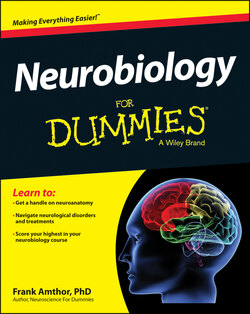Читать книгу Neurobiology For Dummies - Frank Amthor - Страница 4
List of Illustrations
Оглавление1 Chapter 2Figure 2-1: Phospho-lipid molecular structure.Figure 2-2: A simplified ball-and-stick model of a single phospholipid molec...Figure 2-3: Phospho-lipid molecules assemble to form the plasma membrane.Figure 2-4: Two neurons from a rabbit retina: a starburst amacrine cell (left), and a...
2 Chapter 3Figure 3-1: The sodium-potassium pump creates a disequilibrium between sodium and ...Figure 3-2: Event sequence underlying action potential, including voltage across the ...Figure 3-3: Electrical model of the distributed membrane resistance and capacitance...Figure 3-4: Types of glia cells (microglia, astrocytes, and myelin-producing Schwa...
3 Chapter 4Figure 4-1: Structure, molecules, and sequence for neuro-transmitter release.Figure 4-2: Gap junction synapses.
4 Chapter 5Figure 5-1: An antagonistic flexor-extensor muscle pair.Figure 5-2: Myosin-action movement in a sarcomere.Figure 5-3: The alpha motor neuron axon terminal at the end plate.Figure 5-4: A spinal reflex neural circuit.
5 Chapter 6Figure 6-1: The spinal cord in relation to the vertebrae of the back.Figure 6-2: Spinal cord segments and some of their functions.Figure 6-2: Spinal cord segments and some of their functions.Figure 6-3: Gray and white matter inside the spinal cord.Figure 6-4: Spinal cord tracts.Figure 6-5: The cerebellum.Figure 6-6: Divisions of the cerebellum.Figure 6-7: The autonomic nervous system.
6 Chapter 7Figure 7-1: The brainstem: medulla, pons, and midbrain.Figure 7-2: Medulla cross section.Figure 7-3: Midbrain superior and inferior colliculi.Figure 7-4: Neocortex, mesocortex, and allocortex.Figure 7-5: The limbic system.Figure 7-6: The hippocampus.Figure 7-7: A hypnogram.Figure 7-8: EEG sleep patterns during different stages of sleep.
7 Chapter 8Figure 8-1: Coronal brain section showing basal ganglia.Figure 8-2: Organization of the basal ganglia.Figure 8-3: SMA (internal) and PMC (external) motor control circuits.
8 Chapter 9Figure 9-1: Lobes of the neocortex.Figure 9-2: Three ways to section brain.Figure 9-3: Neocortex gray matter and layers.Figure 9-4: Thalamic–cortical connections.Figure 9-5: Neocortex: controller or subroutine?Figure 9-6: The evolution of the prefrontal cortex.Figure 9-7: Brodmann areas of the neocortex.
9 Chapter 10Figure 10-1: Focusing light by the eye.Figure 10-2: Distribution of rods and cones in the retina.Figure 10-3: The neural circuit in the retina.Figure 10-4: Cone spectral sensitivity curves.Figure 10-5: Retinal projections to the thalamus and visual cortex.Figure 10-6: The anatomy of the auditory system.
10 Chapter 11Figure 11-1: Mechano-receptors in the skin.Figure 11-2: The somatosensory cortex.Figure 11-3: Olfactory receptors and the olfactory bulb.Figure 11-4: Projections of the olfactory bulb.Figure 11-5: Taste receptors on the tongue.Figure 11-6: Central projections for taste.
11 Chapter 12Figure 12-1: A memory taxonomy.Figure 12-2: Cortical inputs to the hippocampus.
12 Chapter 13Figure 13-1: The organization and connections of major cell types of the cerebellum.
13 Chapter 14Figure 14-1: Correlated firing.Figure 14-2: Language areas of the brain.
14 Chapter 15Figure 15-1: Meiosis.Figure 15-2: Structures of the developing nervous system.Figure 15-3: Radial glia and neural migration form neocortex minicolumns.
